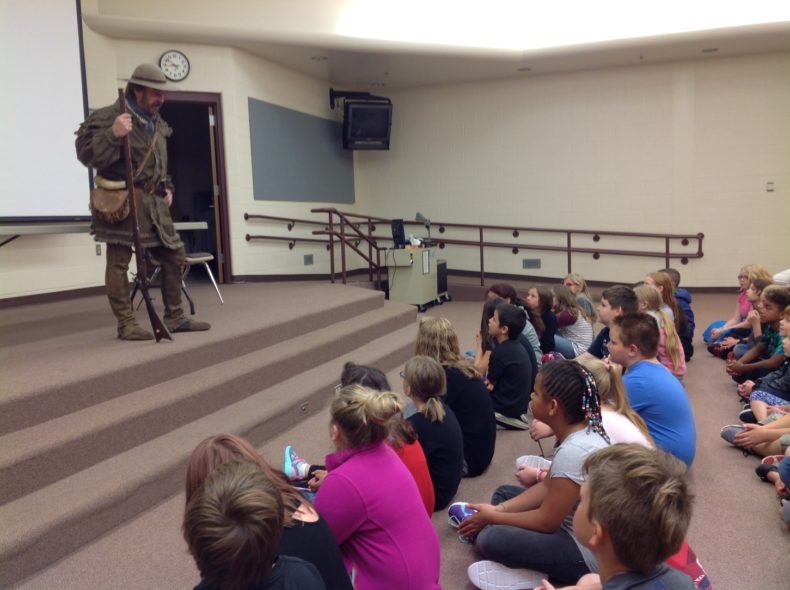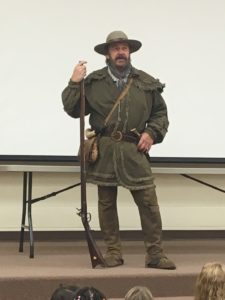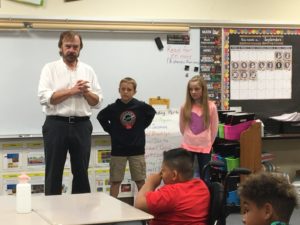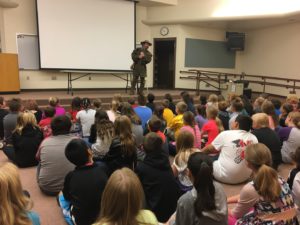Honeywell Foundation brings history to life at Mentone Elementary

Students in grades one through five at Mentone Elementary School were recently treated to a fine arts experience thanks to the Honeywell Foundation in Wabash. The school celebrated “Honeywell Week” Sept. 12 – 14.
The Honeywell Foundation Educational Outreach provides curriculum-based arts-in-education experiences through multiple programs to students in more than 80 schools across the Northern Indiana region each year.
Such experiences include the “Fur Trader”, a true-to-life character compiled from a variety of fur-trade sources. The trader, a Scotsman named Jacob McLinden, takes students on a journey from Montreal to the Indian Country and through a year in the fur trade during the mid-1700s. He familiarizes them with many trade goods, fur-bearing animals, voyageur life, fur-trade vocabulary, music, and the ways of Indians and traders 50 years prior to Indiana’s statehood.
Another experience features the “Hoosier Pioneer”, a first-person interpretation of Andrew Amonett, a true-to-life frontiersman of the Indiana Territory. The presentation, complete with tall tales, deals with various aspects of frontier life and dangers faced in the Indiana Territory just prior to the War of 1812. Topics included trapping, militia service, Indian affairs, tools, weapons, and frontier clothing.
The Honeywell Foundation’s artist residencies have evolved this year from a one visit assembly to a sustained teaching model where our artists will make multiple visits into each classroom in order to drive the curriculum forward. The Foundation selected two ELA standards this fall that its artists will be teaching through the integration of either music or theater.
“Because we know how important it is to differentiate instruction, our artists hope to actively engage all students in the learning process. By giving students the opportunity to learn through an art modality, our artists make lasting connections between the art form and the curricular content,” said Kristi Unger, education curriculum coordinator for The Honeywell Foundation, Inc.
Each artist will make four visits over the course of the school year in each classroom– two in the fall and two in the spring.
“Because we’ll have a longer and more measurable impact, our goal is to see retention of knowledge between the fall and spring visits. Our artists will use various assessment models as students actively participate throughout the lesson in order to demonstrate understanding. Additionally, we hope to demonstrate ways that the arts can be used to teach core curriculum subjects in an impactful way,” said Unger.
The Honeywell Foundation realizes that access to the arts has the power to expand place-based world views while developing 21st Century Skills including critical thinking, communication, collaboration, and the desire to see things outside their immediate focus.
“Unlike many urban areas with growing populations, rural schools face many constraints to integrating the arts into the classroom in a meaningful way to drive forward curriculum standards in core subject areas. However, multiple studies show that the arts have a place in the classroom as a catalyst for learning. We believe it is an important part of our mission to provide arts-based educational experiences to students in our footprint. While we started our education program with page-to-stage student matinees and visiting artists’ performances, arts integration residencies allow us to be more relevant and intentional by working side-by-side with our schools to provide the highest quality education to students in this region,” said Unger.
The Foundation’s goal is for each student to engage in the learning process and learn not only the curricular standard being taught, but also to deepen their knowledge and appreciation for the arts.
The purpose of providing arts integration experiences through the Honeywell Foundation is to extend how students process and retain information by combining several fine arts learning modalities to reach a wider range of students.
“Today, teachers are charged with the task of differentiating instruction, but they don’t always have the resources available to do so. This is especially true in our rural footprint. Through our arts integration experiences, an English Language Arts Standard is taught through an art form, allowing students who may not have made a connection through traditional teaching methods, an opportunity to grow and thrive,” said Unger.
 The Honeywell Foundation started the Education Outreach Program in 1996 with two student matinees. By 1999, in-school artist residencies were added, bringing teaching artists to schools to provide arts-focused assemblies and workshops.
The Honeywell Foundation started the Education Outreach Program in 1996 with two student matinees. By 1999, in-school artist residencies were added, bringing teaching artists to schools to provide arts-focused assemblies and workshops.
Today, more than 40,000 curriculum-based arts-in-education experiences are provided annually to students in the twelve counties surrounding the Honeywell Center.
Educational Outreach programs include page-to-stage matinees, in-school artist residencies, Visual Thinking Strategies instruction, banner and visual arts competitions, collaboration with Carnegie Hall Link Up Music Program, summer camps including theatre, visual arts and vocal arts.


